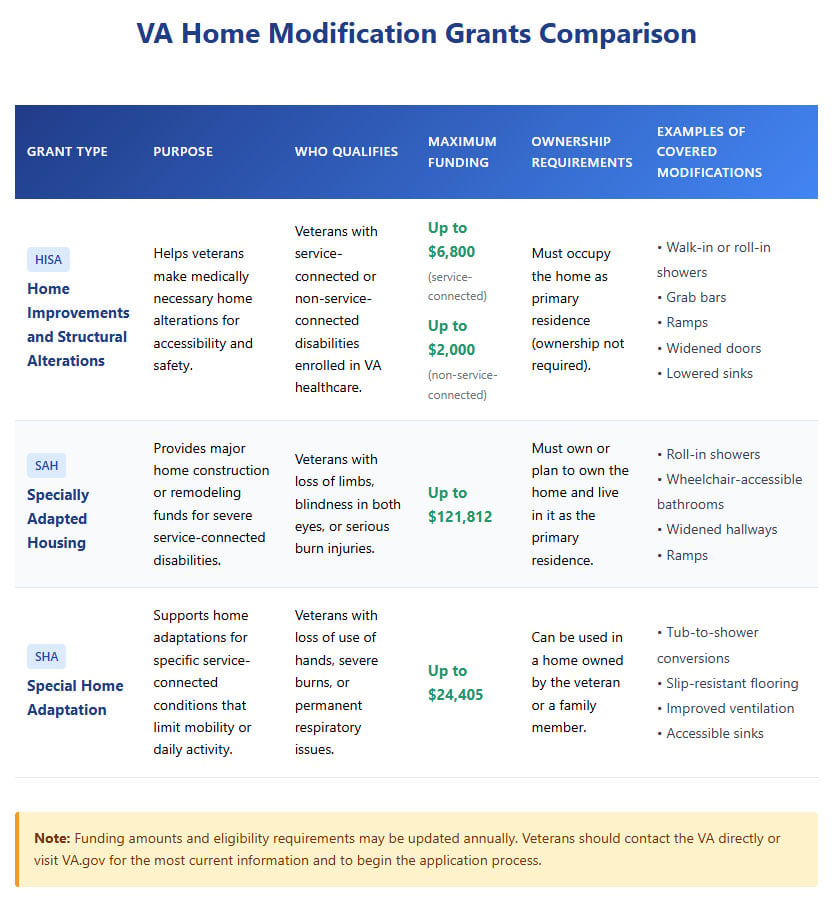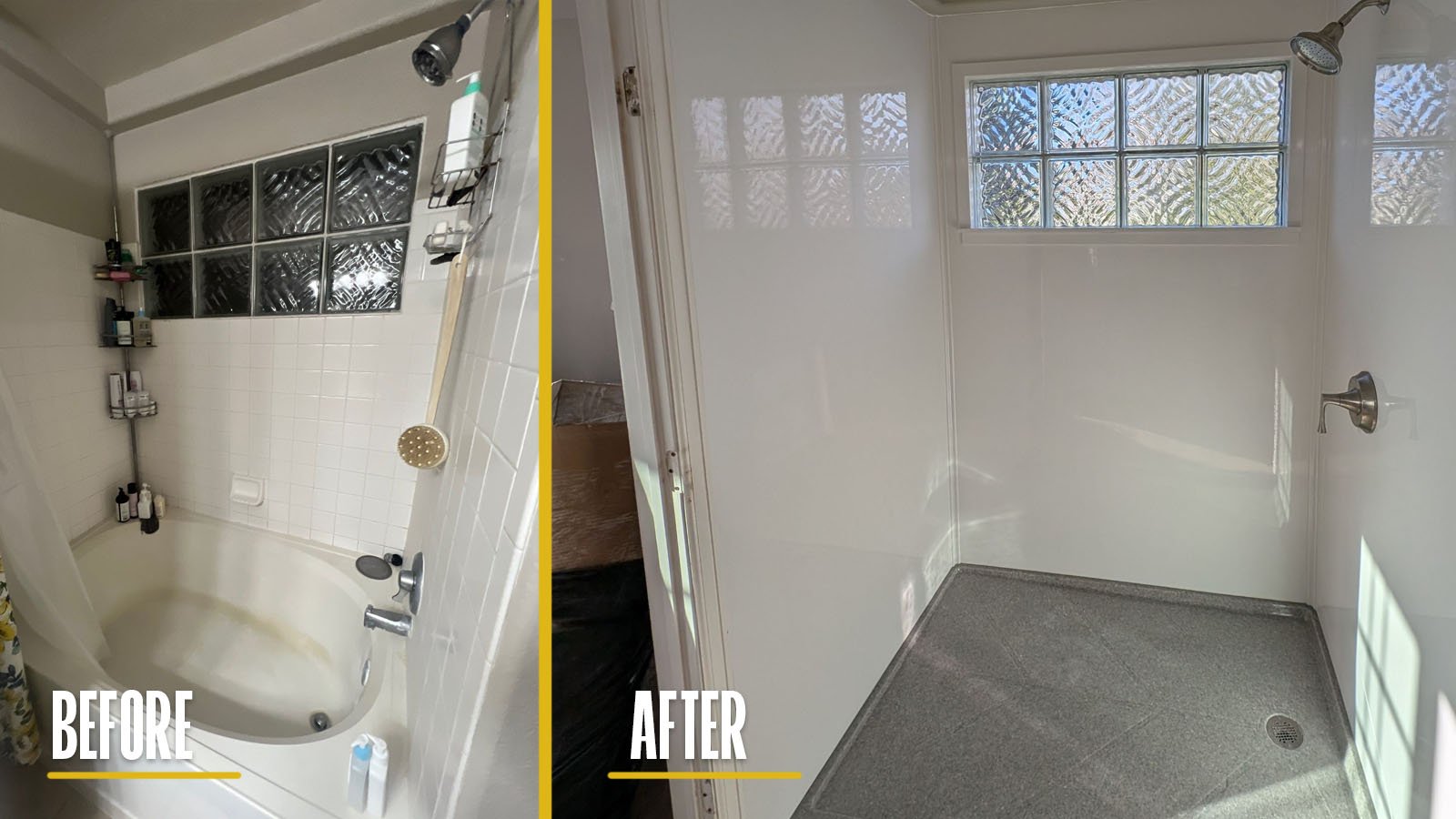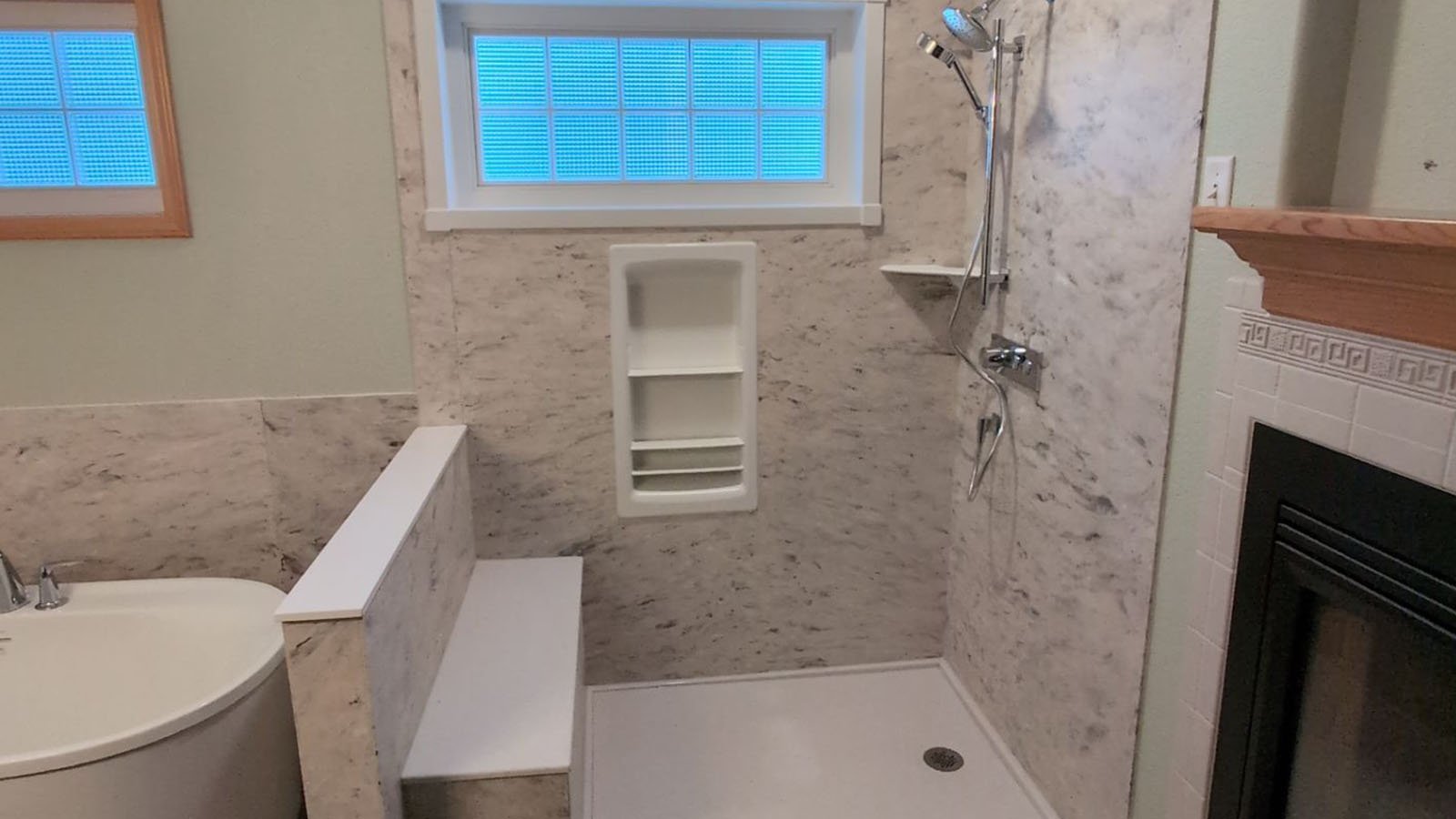VA Funding for Walk-In Baths & Bathroom Remodeling: A Veteran’s Guide
November 6th, 2025
8 min read

At HomePride, we salute the brave men and women of our military—both active duty and veterans—who have served our country with courage and sacrifice. After giving so much, you and your families deserve to live in comfort, safety, and independence.
For many veterans, “home” is more than four walls. It’s a refuge of dignity and self-reliance. Yet when mobility challenges make everyday tasks like bathing risky, the bathroom can become one of the most dangerous rooms in the house. That’s where accessibility modifications like walk-in baths, curbless showers, or widened doorways make all the difference.
The good news: The U.S. Department of Veterans Affairs (VA) offers several programs that help fund these essential home improvements. The challenge is often navigating the paperwork and understanding which grants apply to your specific needs.
This guide was written to honor and assist veterans, service members, and military families in Colorado; helping you confidently navigate VA programs and discover alternative funding if you need it. All information reflects 2025 VA program guidelines.
VA Bathroom Remodel Funding at a Glance
The information in this guide is intended to assist veterans, service members, and military families who need safer, more accessible bathrooms due to disabilities or mobility limitations. Its purpose is to explain and guide them towards financial resources that are available to assist them with costly upgrades. The two main forms of financial aid available are grants and loans.
What Is a Grant?
A grant is money provided by the federal government that does not need to be repaid, unlike a loan. According to VA.gov, VA housing grants are specifically designed to help veterans make medically necessary home modifications that improve accessibility, safety, and independence
Grants differ from VA loans, which must be repaid. For most veterans, using a grant is the most affordable and sustainable way to fund accessibility improvements like a walk-in tub or roll-in shower. However, whether it be grants or loans, any financial assistance provided is determined by whether the applicant is facing service connected disabilities or non-service-connected disabilities.
Understanding ‘Service-Connected’ vs. ‘Non-Service-Connected’
Service-connected disabilities are conditions caused or worsened by military service. The VA defines a severe service-connected disability as a long-lasting condition (or expected to last a year or more or result in death) that prevents a veteran from performing basic work activities or adapting to other work.
As veteran advocate Vets National explains, examples of severe service-connected disabilities include but are not limited to:
- Severe burns
- Loss of sight in both eyes or severe hearing loss
- Chronic back pain with current back disability
- Breathing problems from lung conditions
- Traumatic brain injury (TBI)
- Anxiety
- Depression
- Post-traumatic stress disorder (PTSD)
Non-service-connected disabilities are medical conditions unrelated to service, but still recognized by the VA if they affect mobility or daily living. These typically qualify for smaller grant amounts. To better understand these conditions and their impact on funding eligibility, view this article by attorney Robert B. Goss, or contact your local VA office.
What ‘Medically Necessary’ Means
A modification is considered medically necessary when it helps a veteran perform daily activities safely and independently based on a physician’s evaluation. For instance, a roll-in shower is justified for a veteran with limited mobility, while luxury upgrades like spa jets or heated floors would not qualify.
All HISA applications require a VA physician’s prescription and a completed VA Form 10-0103.
⚠️ Note: Work cannot start until the VA approves the project in writing.
Key Requirements for Approval
To ensure eligibility and avoid costly delays, applicants must meet several baseline requirements:
- Provide VA Form 10-0103 and a physician’s prescription detailing the medical necessity of the requested improvements.
- Use a VA-approved contractor and submit itemized bids that outline labor, materials, and total costs.
- Wait for formal VA approval before beginning any work. Starting construction early can result in ineligibility for reimbursement or denial of the claim.
Once you’ve confirmed your eligibility and gathered your documentation, the next step is identifying which VA grant best fits your needs.
📌 KEY TAKEAWAY: Veterans and their families must complete a VA Form 10-0103 (Application for Assistance in Acquiring Home Improvement and Structural Alterations). Don’t forget your VA doctor’s prescription; it’s non-negotiable.
Which VA Programs Fund Bathroom Remodels?
Once approved, the VA has three main programs designed to help veterans with accessibility upgrades. Each one serves a different purpose, with unique eligibility and funding limits.
1. Specially Adapted Housing (SAH) Grant
- Funding: Up to $121,812 (FY 2025)
- Who qualifies: Veterans with the most severe service-connected disabilities, such as loss of multiple limbs, blindness in both eyes, or serious burn injuries.
- What it’s for: Permanent modifications that make a home fully accessible, like installing roll-in showers, widening doorways, or creating wheelchair-accessible bathrooms.
- Homeownership requirement: You must own (or plan to own) the home and live in it as your primary residence.
Example: A veteran who uses a wheelchair after losing a leg in service may qualify for the SAH grant to redesign their bathroom with no-threshold shower entry, reinforced grab bars, and accessible sink height.
2. Special Home Adaptation (SHA) Grant
- Funding: Up to $24,405 (FY 2025)
- Who qualifies: Veterans with disabilities such as loss of use of both hands, certain severe burns, or permanent respiratory injuries.
- Flexibility: This grant can be used if the veteran or a family member owns the home.
- Use cases: Bathroom modifications for easier breathing, mobility, or handling daily routines—like adding anti-slip flooring or converting a standard tub into a safer, accessible one.
Example: A veteran with severe respiratory illness might qualify for the SHA grant to add better ventilation or safer access to a low-step shower to reduce exertion.
3. Home Improvements and Structural Alterations (HISA) Grant
- Funding: Up to $6,800 for service-connected disabilities or $2,000 for non-service-connected disabilities.
- Purpose: Covers “medically necessary improvements and structural alterations” to a veteran’s primary residence (VA.gov, Prosthetics and Sensory Aids Service).
- Examples of covered improvements:
- Roll-in or walk-in showers
- Widened doors for wheelchair access
- Handrails or grab bars
- Lowered countertops or sinks
- Ramps or entryway modifications

Once you’ve chosen the right program, the next step is understanding how long the VA approval process typically takes.
How Long Does the Application Process Take?
While every case varies based on the veteran’s eligibility, the type of grant, and local VA processing volume, applicants can typically expect the full approval and reimbursement process to take between 6–12 weeks from start to finish. Below is a general breakdown of what to expect:
1. Preparation (1–2 weeks)
Before submitting the application, veterans should gather all required documentation, including a physician’s prescription verifying the medical necessity of the modification and a completed VA Form 10-0103 (Application for Assistance in Acquiring Home Improvements and Structural Alterations). During this stage, it’s also critical to obtain itemized bids from VA-approved contractors, clearly detailing labor, materials, and total costs. These documents form the foundation of a compliant submission and help avoid delays during review.
2. Review and Inspection (2–6 weeks)
Once submitted, the VA reviews the application for eligibility and accuracy. This phase may include a home visit or inspection by a VA representative to verify the need and scope of the proposed work. If additional information or corrections are needed, this can extend the review period—so submitting a complete and detailed application is key.
3. Processing and Funding (1–2 weeks)
After approval, the VA processes the grant and releases funds directly to the veteran or contractor, depending on the grant type (HISA, SAH, or SHA). The approved amount and payment terms will be outlined in writing, ensuring all parties understand the funding limits and reimbursement expectations.
4. Reimbursement and Final Inspection (2–4 weeks)
Once the modifications are completed, the VA may conduct a final inspection to confirm that all approved work was properly executed and meets accessibility standards. Upon successful inspection, reimbursement or final payment is issued. The total timeline can vary depending on contractor scheduling, regional VA office workload, and the complexity of the remodel.
⏳ Tip: VA housing grants are funded on an annual fiscal-year basis, meaning they operate under yearly budget limits. When those funds are depleted, new applications may be delayed until the next fiscal cycle begins (October 1).
Applying early in the year—or as soon as you have your medical documentation ready—can significantly improve your chances of faster approval and funding.
What Does the VA Require from Contractors and Bids?
The VA’s process ensures accountability and quality for veterans. According to the VA Contractor’s Guide, contractors must:
- Provide itemized, detailed bids separating labor and materials.
- Include all permit requirements and city compliance notes.
- Sign the bid alongside the veteran.
- For SAH projects, maintain a VA Builder ID and proper certifications (e.g., Equal Employment Opportunity, Affirmative Marketing).
Each project is reviewed by a Regional Loan Center (RLC) and may involve a Specially Adapted Housing (SAH) agent, who helps coordinate the process.
💡 Tip: Many veterans obtain multiple contractor bids. This helps the VA confirm pricing fairness and ensures your project aligns with approved safety standards.
Helpful Links
Download the VA’s Contractor’s Guide here
Download the Wounded Warrior’s Bidding Price Guide here

At HomePride, we’ve walked dozens of Colorado veterans through the VA grant process, helping them avoid delays and secure the funding they deserve.
Don’t wait for paperwork to slow you down. Schedule your no-hassle, no-obligation consultation today, and let our team help you navigate the VA process from start to finish. Let’s start the conversation today
If VA Grants Don’t Cover Everything: Alternative Funding Options?
Not every veteran will qualify, and not every project will fit VA rules. Here’s how VA grants stack up against other options:
Colorado-Specific Assistance
Veterans in Colorado may qualify for state and local home modification programs that can supplement or bridge gaps in VA funding. Options include the Colorado Medicaid Home Modification Benefit, which provides up to $14,000 in lifetime assistance, as well as city and county repair grants.
The Colorado Home Modification Tax Credit provides up to $5,000 in state income tax credits for retrofitting a home for accessibility, for qualifying individuals with a disability or impairment.
Many of these programs can be combined with VA grants to make remodels more affordable and comprehensive.
How should veterans decide between VA grants and other financing?
Veterans considering bathroom modifications should evaluate their specific situation, timeline needs, and financial resources. Here’s the truth:
- If you qualify for a VA grant—start there. It’s free money with quality oversight, even if the process takes time.
- If time is critical or you don’t qualify—look at contractor financing or equity options.
And one more thing: partner with a contractor who knows the VA system. The difference between a stalled application and a completed remodel often comes down to experience.
What’s the smartest first step for veterans considering a remodel?
Bathroom safety isn’t a luxury—it’s peace of mind. VA programs exist to make homes safer and more accessible for veterans—but the path requires patience, paperwork, and timing. Since these grants are budgeted yearly, starting your application now ensures you don’t lose valuable time—or risk waiting another year for approval.
With the right approach, you can turn government red tape into a bathroom that restores independence, safety, and dignity.
To every veteran, service member, and military family—HomePride thanks you for your dedication and sacrifice. You’ve earned the right to live in comfort, with the independence and safety that makes life easier and more enjoyable. That’s why our mission is more than just remodeling—it’s about honoring your service by helping you build a home that truly supports your lifestyle.
If you’re ready to explore ways to make your home safer, more accessible, and designed for comfort, with a company that is familiar with the VA process, HomePride is here to lock arms and guide you every step of the way. We’ve helped dozens of Colorado veterans complete VA-funded remodels, and get them the bathrooms they deserve faster, while making them amazingly affordable.
💻 For your no-hassle, no obligation consultation, click here
Quick Links for Veterans
- VA Form 10-0103: Application for Home Improvement and Structural Alterations (HISA)
- VA Contractor’s Guide
- Wounded Warrior’s Bidding Price Guide
FREQUENTLY ASKED QUESTIONS
Q1: Does the VA cover walk-in tubs such as the Kohler Walk-In Bath?
A: Yes, VA programs like the Home Improvements and Structural Alterations (HISA) grant, Specially Adapted Housing (SAH) grant, and Special Home Adaptation (SHA) grant may cover the cost of installing a walk-in tub—including Kohler models—if they are deemed medically necessary for accessibility or safety.
Q2: What are the eligibility requirements?
A: The walk-in tub must meet VA standards, such as having no jets, ADA-compliant grab bars, accessible controls, and a safe transfer platform. The veteran must provide a medical justification from a VA physician and enroll in VA healthcare. Grants do not cover jetted tubs or luxury spa-style models (i.e. jacuzzi, spa baths, etc.)
Q3: What kinds of bathroom modifications are not covered under VA HISA or adaptive housing grants?
A: The VA limits coverage to medically necessary and structural changes that improve accessibility. Some examples of excluded work include exterior features like decking or patios, spas, Jacuzzis, or hot tub installations, routine home maintenance (e.g. replacing a roof, HVAC, nonessential plumbing) and more. If in doubt, always ask your VA case manager or prosthetics liaison whether the proposed modification is eligible — and get that in writing before starting.
Coley McAvoy is a Colorado-based home remodeling writer and content strategist with 20+ years in inbound marketing. He blends creative storytelling with proven strategy to educate, build trust, inspire homeowners, and deliver lasting impact, based on sincerity and service.
